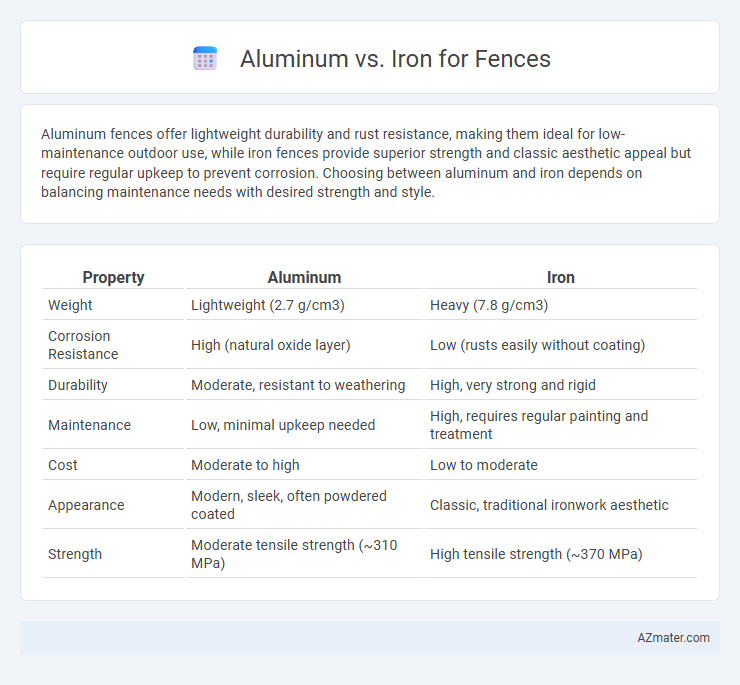Aluminum fences offer lightweight durability and rust resistance, making them ideal for low-maintenance outdoor use, while iron fences provide superior strength and classic aesthetic appeal but require regular upkeep to prevent corrosion. Choosing between aluminum and iron depends on balancing maintenance needs with desired strength and style.
Table of Comparison
| Property | Aluminum | Iron |
|---|---|---|
| Weight | Lightweight (2.7 g/cm3) | Heavy (7.8 g/cm3) |
| Corrosion Resistance | High (natural oxide layer) | Low (rusts easily without coating) |
| Durability | Moderate, resistant to weathering | High, very strong and rigid |
| Maintenance | Low, minimal upkeep needed | High, requires regular painting and treatment |
| Cost | Moderate to high | Low to moderate |
| Appearance | Modern, sleek, often powdered coated | Classic, traditional ironwork aesthetic |
| Strength | Moderate tensile strength (~310 MPa) | High tensile strength (~370 MPa) |
Introduction: Overview of Aluminum vs Iron Fencing
Aluminum and iron are two popular materials for fencing, each with distinct advantages in durability and maintenance. Aluminum fences offer lightweight corrosion resistance and require minimal upkeep, making them suitable for various climates. Iron fences provide superior strength and security but may need regular treatment to prevent rust and extend lifespan.
Material Composition: Aluminum and Iron Explained
Aluminum fences are composed primarily of lightweight aluminum alloy, offering corrosion resistance and minimal maintenance, while iron fences consist mainly of carbon-rich cast or wrought iron, providing exceptional strength and durability but requiring rust protection. Aluminum's natural oxide layer prevents rust and enables a longer lifespan in humid or coastal environments, whereas iron's susceptibility to oxidation demands regular painting or galvanizing. The distinct elemental compositions influence their weight, strength-to-weight ratio, and maintenance needs, making aluminum ideal for low-maintenance applications and iron suited for robust, ornamental fencing.
Durability and Longevity Comparison
Aluminum fences offer superior corrosion resistance due to their natural oxide layer, making them highly durable in humid or coastal environments compared to iron fences that are prone to rust without regular maintenance. While iron provides exceptional strength and can withstand heavy impacts, its longevity is often compromised by oxidation and structural weakening over time. Choosing aluminum ensures a long-lasting, low-maintenance fence solution that retains its appearance and structural integrity for decades.
Maintenance Requirements
Aluminum fences require significantly less maintenance than iron fences due to their resistance to rust and corrosion, especially in humid or coastal environments. Unlike iron, which needs regular painting and rust-proofing to prevent deterioration, aluminum fences maintain their appearance with occasional cleaning using mild soap and water. This low maintenance demand makes aluminum a cost-effective and durable choice for long-term fence installation.
Aesthetic Options and Design Versatility
Aluminum fences offer superior aesthetic options and design versatility due to their lightweight nature, enabling intricate patterns and customizable shapes that mimic wrought iron without the heavy maintenance. Iron fences provide a classic, robust appearance with traditional ornamental designs but have limited flexibility in design updates and require regular rust prevention. Choosing aluminum enhances creative freedom in fence styles, colors, and finishes, making it ideal for modern and diverse landscaping themes.
Cost Analysis: Initial and Long-Term Expenses
Aluminum fences generally have a higher initial cost compared to iron due to their lightweight design and corrosion-resistant properties, but require less maintenance, translating to lower long-term expenses. Iron fences, though often cheaper upfront, demand regular painting and rust prevention treatments, which increase their total cost over time. Evaluating both materials reveals that aluminum offers better cost-efficiency for durable fencing with minimal upkeep.
Security and Strength Differences
Aluminum fences provide moderate security with resistance to rust and corrosion, making them ideal for coastal areas but generally less impact-resistant than iron. Iron fences offer superior strength and durability, capable of withstanding significant force, enhancing overall perimeter security but require regular maintenance to prevent rust. The choice between aluminum and iron depends on balancing long-term strength needs against corrosion resistance and upkeep.
Environmental Impact and Sustainability
Aluminum fences offer significant environmental benefits due to their recyclability and lightweight nature, reducing transportation emissions and resource use during manufacturing. Iron fences, though durable, require energy-intensive smelting and frequent maintenance with paints and rust inhibitors that can introduce harmful chemicals into the environment. Choosing aluminum supports sustainable practices by minimizing carbon footprint and enabling repeated recycling without quality loss.
Installation Process and Ease
Aluminum fences are lightweight, allowing for quicker and easier installation compared to heavier iron fences, which often require more manpower and specialized tools. Aluminum panels typically come pre-assembled, simplifying the alignment and securing process, while iron fences may demand welding or bolting on-site, increasing labor time. The corrosion resistance of aluminum also reduces maintenance concerns post-installation, unlike iron which often needs protective coatings to prevent rust.
Choosing the Right Material for Your Fence Needs
Aluminum fences offer lightweight durability and resistance to rust, making them ideal for coastal or humid environments, while iron fences provide superior strength and security with a classic, ornamental appeal. Budget considerations favor aluminum due to lower material and maintenance costs, whereas iron requires periodic painting and rust treatment to maintain longevity. Selecting the right fence material depends on factors such as climate, aesthetic preference, security needs, and long-term maintenance commitment.

Infographic: Aluminum vs Iron for Fence
 azmater.com
azmater.com